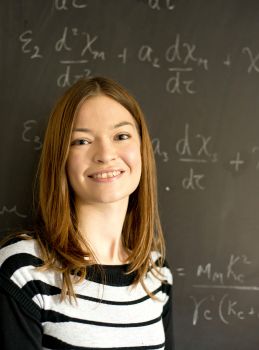Broadcast: News items
Undergraduate helps to figure out the cause of disease
Posted on behalf of: School of Mathematical and Physical Sciences
Last updated: Wednesday, 18 July 2012

Laurie Crossley
Laurie Crossley gave up part of her summer holidays to try to find out how changes in vital cell functions are linked to debilitating diseases in humans – using mathematics.
Now Laurie is awaiting publication of her findings in the Bulletin of Mathematical Biology – a rare achievement for an undergraduate.
She graduates in Mathematics this afternoon (Wednesday 18 July) and her experience has inspired her to study for a doctorate at Sussex in the same subject.
Laurie was funded by a Junior Research Associate (JRA) bursary, awarded by the University to talented undergraduates so that they can get a taste of real research outside their normal studies.
Laurie worked with postgraduate researcher Caroline Garrett and neuroscientist Dr Majid Hafezparast from the School of Life Sciences.
Laurie led the study with help from Mathematics lecturer Dr Anotida Madzvamuse and Julie Carr from the Doctoral School, which supports postgraduate students and young researchers.
The resulting academic paper, ‘From the cell membrane to the nucleus: Unearthing transport mechanisms for dynein’, uses mathematics to model the movement of a substance called cytoplasmic dynein, a “motor” protein that transports other substances inside a single cell.
Laurie says: “We used mathematics to try to describe dynein’s movement and to find the key properties which may have been affected because of a disease. We worked out dynein’s speed and the distance it travels over time. This is important for biology as in some diseases dynein doesn't move properly, which affects how fast and how far it can travel.”
Mutations in dynein have been found to cause Charcot-Marie-Tooth disease (an inherited genetic disorder causing progressive loss of muscle tissue and touch sensation across various parts of the body), spinal problems and severe intellectual disabilities in humans.
Laurie says: “After completing my JRA, I wanted to continue with the work and so I carried on the research as a project which formed part of my degree.
“Now I’m going to continue at Sussex to study for a PhD based on a topic similar to my JRA work and supported by a studentship from Mathematical and Physical Sciences and Life Sciences.
“I had never thought of going into research before coming to Sussex, but my experience on the JRA scheme has inspired me to continue. The support from everyone at the University has been exceptional.”

